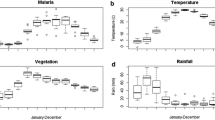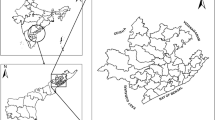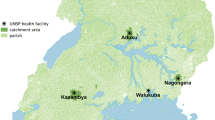Abstract
Malaria is a major public health problem especially in the tropics with the potential to significantly increase in response to changing weather and climate. This study explored the impact of weather and climate and its variability on the occurrence and transmission of malaria in Akure, the tropical rain forest area of southwest and Kaduna, in the savanna area of Nigeria. We investigate this supposition by looking at the relationship between rainfall, relative humidity, minimum and maximum temperature, and malaria at the two stations. This study uses monthly data of 7 years (2001–2007) for both meteorological data and record of reported cases of malaria infection. Autoregressive integrated moving average (ARIMA) models were used to evaluate the relationship between weather factors and malaria incidence. Of all the models tested, the ARIMA (1, 0, 1) model fits the malaria incidence data best for Akure and Kaduna according to normalized Bayesian information criterion (BIC) and goodness-of-fit criteria. Humidity and rainfall have almost the same trend of association in all the stations while maximum temperature share the same negative association at southwestern stations and positive in the northern station. Rainfall and humidity have a positive association with malaria incidence at lag of 1 month. In all, we found that minimum temperature is not a limiting factor for malaria transmission in Akure but otherwise in the other stations.




Similar content being viewed by others
References
Box GEP, Jenkins GM, Reinsel GC (1976) Time series analysis: forecasting and control. Holden-Day, San Francisco
Craig MH, Snow RW, Le Sueur D (1999) A climate-based distribution model of malaria transmission in sub-Saharan Africa. Parasitol Today 15:105–111
Githeko AK, Ndegwa W (2001) Predicting malaria epidemics in Kenyan highlands using climate data: a tool for decision makers. Glob Change Hum Health 2:54–63
Odongo-Aginya E, Ssegwanyi G, Kategere P, Vuzi PC (2005) Relationship between malaria infection intensity and rainfall pattern in Entebbe peninsula, Uganda. Afr Health Sci 5:238–245
Oluleye A, Akinbobola A (2010) Malaria and pneumonia occurrence in Lagos, Nigeria: role of temperature and rainfall. Afr J Environ Sci Technol 4(8):506–516
Pampana E (1969) A textbook of malaria eradication. Oxford University Press, London
WHO (2003) The world health report 2003. Shaping the future. World Health Organization, Geneva
Tian LW, Bi Y, Ho SC, Liu WJ, Liang S, Goggins WB, Chan EYY, Zhou SS, Sung JJY (2008) One-year delayed effect of fog on malaria transmission: a time-series analysis in the rain forest area of Mengla County, south-west China. Malar J 7:110
Teklehaimanot HD, Lipsitch M, Teklehaimanot A, Schwartz J (2004) Weather-based prediction of Plasmodium falciparum malaria in epidemic-prone regions of Ethiopia I. Patterns of lagged weather effects reflect biological mechanisms. Malar J 3:41
Vanderwal T, Paulton RJL (2000) Malaria in the Limbé valley of northern Haiti: a hospital-based retrospective study, 1975–1997. Pan Am J Publ Health 7(3):162–167
Author information
Authors and Affiliations
Corresponding author
Rights and permissions
About this article
Cite this article
Akinbobola, A., Omotosho, J.B. Predicting Malaria occurrence in Southwest and North central Nigeria using Meteorological parameters. Int J Biometeorol 57, 721–728 (2013). https://doi.org/10.1007/s00484-012-0599-6
Received:
Revised:
Accepted:
Published:
Issue Date:
DOI: https://doi.org/10.1007/s00484-012-0599-6




